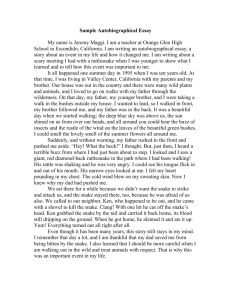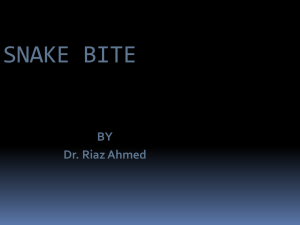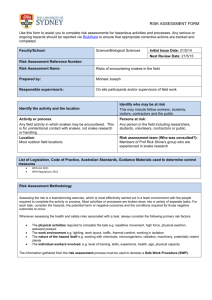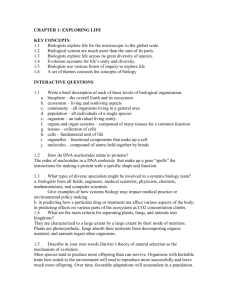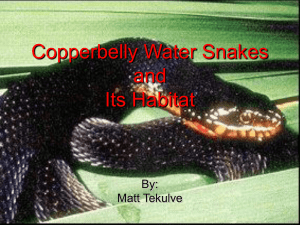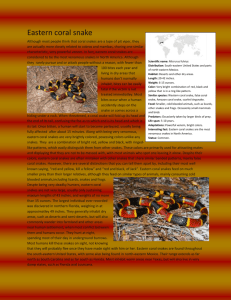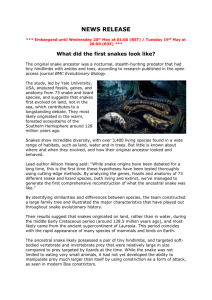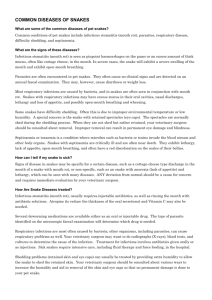Snakes - Florida's Venomous Snakes
advertisement
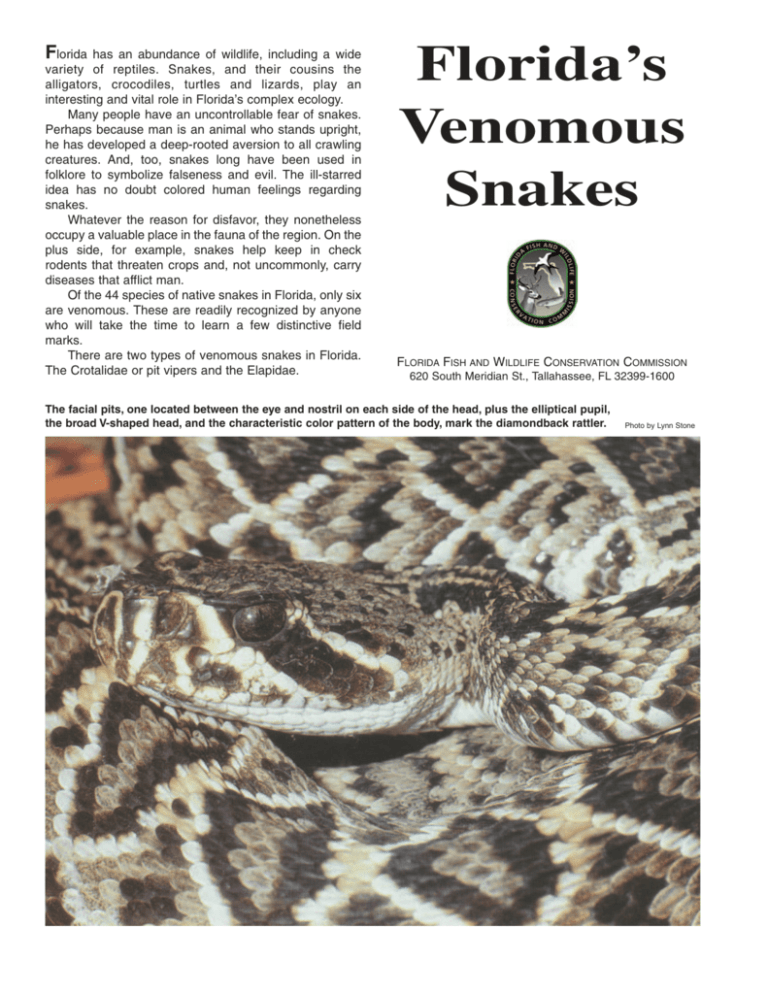
Florida has an abundance of wildlife, including a wide variety of reptiles. Snakes, and their cousins the alligators, crocodiles, turtles and lizards, play an interesting and vital role in Florida’s complex ecology. Many people have an uncontrollable fear of snakes. Perhaps because man is an animal who stands upright, he has developed a deep-rooted aversion to all crawling creatures. And, too, snakes long have been used in folklore to symbolize falseness and evil. The ill-starred idea has no doubt colored human feelings regarding snakes. Whatever the reason for disfavor, they nonetheless occupy a valuable place in the fauna of the region. On the plus side, for example, snakes help keep in check rodents that threaten crops and, not uncommonly, carry diseases that afflict man. Of the 44 species of native snakes in Florida, only six are venomous. These are readily recognized by anyone who will take the time to learn a few distinctive field marks. There are two types of venomous snakes in Florida. The Crotalidae or pit vipers and the Elapidae. Florida’s Venomous Snakes FLORIDA FISH AND WILDLIFE CONSERVATION COMMISSION 620 South Meridian St., Tallahassee, FL 32399-1600 The facial pits, one located between the eye and nostril on each side of the head, plus the elliptical pupil, the broad V-shaped head, and the characteristic color pattern of the body, mark the diamondback rattler. Photo by Lynn Stone The Crotalidae are readily identified by the facial pits, one located between the eye and nostril on each side of the head. The elliptical eye pupil and broad, roughly Vshaped head are other identifying features of this group. Included in the family are the diamondback rattlesnake, canebrake rattlesnake, pigmy rattlesnake, cottonmouth, and the copperhead. The venom of these snakes is haemotoxic, that is, it destroys the red blood cells and the walls of the blood vessels of the victim. Photo by Wallace Hughes DIAMONDBACK RATTLESNAKE a 3-1/2-foot-long specimen (above) Photo by Bruce Cockcroft CANEBRAKE RATTLESNAKE (right) The Elapidae, represented in Florida by the coral snake, have neurotoxic venom. This attacks the nervous system of a victim, bringing on paralysis. Diamondback Rattlesnake The eastern diamondback is the largest and most dangerous of our native snakes. It also ranks high on the list of venomous snakes of the world. Its large body size, quantity of venom, aggressive defensive tactics and PIGMY RATTLESNAKE coiled at rest and closeup of head Photo by Lynn Stone tremendous striking speed make this snake one to be treated with extreme caution. The diamondback is recognized by a distinctive pattern of yellow-bordered diamond-shaped body markings. Brittle, button-shaped segments form a rattling mechanism at the end of the tail. The arrow-shaped head is much wider than the neck. Found throughout Florida, the diamondback occurs in every county and on many of the coastal islands. It may be encountered in almost any habitat, but most commonly frequents palmetto flatlands, pine woods, abandoned fields, and brushy and grassy areas. In most situations, this snake is difficult to spot since its color pattern blends into the background. When disturbed the rattler assumes a defensive position with the body coiled upon itself, rattle free and elevated to sound a warning whirr, and head and neck raised in an S-position. From this stance, when the target is close, the rattler can repeatedly deliver its stabbing strike and return to its original position so rapidly that the movements appear only as a blur to the human eye. The effective striking distance is from one-third to more than one-half the length of the snake’s body. Recurved fangs or teeth, lying folded inside the roof of the rattler’s mouth, are self-erecting when the mouth is opened wide during a strike. As the fangs pierce the victim, pressure exerted on the venom sacs extrude poison into the wound. The rattler does not have to be coiled to strike—it can strike from any position and in any direction. When disturbed it generally, but not always, sounds a warning rattle. The diamondback may shed its skin from three to five Photo by Bruce Cockcroft times a year, depending upon the amount of food it takes in, which in turn governs its rate of growth. A new segment is added to the rattle at each shedding. Some rattle sections may be broken off as the snake travels about, and it is somewhat unusual to find a perfect set. In the light of its irregular rate of adding new rattle segments, it may be concluded that the number of segments in a rattle in no way determines the age of a diamondback. Although it may attain a body length of over eight feet, it is rare to find a rattler over seven feet long. Rattlesnakes feed on small warm-blooded animals, mainly rabbits, squirrels, rats, mice, shrews, and occasionally birds. It gives birth to from 9 to 15 young at a time. Newly born rattlers are equipped with venom and the hollow hypodermic needle fangs to inject it. This species in commercially valued for its hide, meat and venom and for exhibition purposes. It renders economic service to farmers by preying on cropdestroying rodents. Canebrake Rattlesnake The canebrake rattlesnake is restricted mainly to northern Florida but has been reported as far south as Alachua County. This snake is the southern form of the timber rattlesnake found in other portions of the United States. The canebrake is recognized by its grayish brown or pinkish buff color, with dark bands across its body, orange or rusty-red stripes down the middle of its back, and a brown or black tail which terminates in a rattle. As in other rattlesnakes, the head is much wider than the neck. It is more slender in build than the average diamondback. Florida specimens seldom measure more than five feet in length. Usually found in the flatwoods, river bottoms and hammocks, the canebrake also occurs in abandoned fields and around farms. During hot weather, it may seek out low swampy ground. Pigmy Rattlesnake The pigmy rattlesnake, also called ground rattler, is common throughout Florida. It is found in every county and on many of the offshore islands. Its rattle is small and slender and produces a sound like the buzzing of an insect. This warning signal can be heard for no more than a few feet away. Stout-bodied for so small a snake, it is gray in color and marked prominently with rounded, dusky spots. Starting at the base of the head, reddish spots alternate Photo by Bruce Cockcroft COTTONMOUTH—revealing its “cotton” mouth and a favorite resting spot (below) Photo by Gregory Lee COPPERHEAD—a rare northwest Florida resident with the black along the midline of the back. Most pigmy rattlers measure less than 18 inches in length. This species feeds on small frogs, lizards, mice and other snakes. Like other members of the pit-viper family, it does not lay eggs, but gives live birth to its young. Look for the pigmy rattlesnake in palmetto flatwoods, or in areas of slash pine and wire grass. It may be encountered in almost any locality where there are lakes, ponds, or marshes. It is fortunate that the ground rattler is small, as it has a feisty disposition, and is quick to strike. Its bite produces pain and swelling which usually subsides in a few days. While its bite could be fatal to humans under certain circumstances, no deaths from the bite of this species have been recorded. Cottonmouth The cottonmouth moccasin is a pit viper without rattles. It grows to large size, exceeding five feet in length. Most Florida specimens average about three feet. It occurs commonly in every county in the state and on many coastal islands. Color pattern of the cottonmouth varies from olivebrown to black, with or without dark crossbands on the body. It is stout-bodied with an abruptly tapering tail, and a broad head much wider than the neck. A distinctive mark is a dark band extending from the eye to the rear of Photo by Bruce Cockcroft the jaw. A drooping mouthline and protective shields overhanging its eyes give it a sullen appearance. Often when disturbed it draws into a loose coil, cocks its head upwards and opens its mouth wide to reveal the whitish interior lining, hence the name cottonmouth. From this lose-coiled stance, it lunges out in a fast strike to embed its venom-carrying fangs. It usually retains a hold on its prey, chewing in order to drive its fangs deeper into its victim. It does not have to be coiled to strike, but can deliver a bite from almost any position, either in or out of the water. It is an unpredictable snake. Some individuals are calm and sluggish while others may be very aggressive. A water-loving snake, the cottonmouth is found along stream banks, in swamps, margins of lakes and in treebordered marshes. It hunts at night for its prey of fish, frogs and other snakes, lizards and small mammals. The cottonmouth gives birth to six to 12 young that are born with venom sacs loaded and ready for action. The baby snakes are boldly marked with reddish-brown crossbands and bright yellow tails. At this stage they can be mistaken for copperheads. During the day, the cottonmouth spends time resting near water, often in a grassy patch, on a pile of debris, in brushy places and in low trees hanging over the water. The venomous bite of this reptile results in great pain and severe swelling. With immediate and proper medical treatment, the bite is only occasionally fatal to humans. Copperhead Florida is the southern extent of the range of the copperhead. At that, it is hardly more than of rare occurrence in a few counties in the northwest portion of the state, notably Liberty and Gadsden counties. A handsome snake, it is pinkish tan in color with reddishbrown crossbands on the body. These bands are wide along the sides and narrow along the back to form something of a hourglass shape. The copper-colored head is wider than the neck. Average length is 30 inches. Many snakes that are reported to be copperheads turn out to be young cottonmouths which are similar in appearance. So uncommon is this species here that very few bites, and no resulting deaths, have been reported from Florida. Coral Snake The coral snake’s venom is the most potent of any of North America’s snakes. This colorful species is closely related to the notorious cobra, krait, and mamba. The coral is shy and secretive, seldom aggressive unless startled, tormented or hurt. It has short fangs and a small mouth. It typically does not strike like the pit vipers but bites and chews to inject its venom. Especially vulnerable parts of the human anatomy to coral snake bites are fingers and toes. Most bites occur when a “pretty little snake” is picked up by someone who does not recognize it as a venomous one. The coral snake is often confused with the harmless scarlet kingsnake, which it closely resembles. Both CORAL SNAKE This Agency does not allow discrimination by race, color, nationality, sex, or handicap. If you believe you have been discriminated against in any program, activity or facility of this agency, write to: Florida Fish and Wildlife Conservation Commission, 620 S. Meridian St., Tallahassee, FL 32399-1600, or to Office for Human Relations, USFWS, Dept. of Interior, Washington, D.C. 20240 Revised 2004 Photo by Lynn Stone snakes are brightly colored with red, black and yellow bands. A helpful rhyme goes, “red touch yellow, kill a fellow; red touch black, good for Jack.” The red rings of the coral borders the yellow. The red of the kingsnake borders the black. Also, the coral has a black nose, the kingsnake a red nose. The coral snake is a small-sized, slender-bodied reptile with the narrow head and round eye pupils characteristic of nonvenomous species. The largest coral snake on record measured 47 inches, but most specimens are less than 24 inches in length. Found more or less commonly throughout Florida, the coral inhabits pine woods, pond and lake borders and the jungle-like growth of Florida’s hammocks. It favors such places as rotting logs, piles of decaying vegetation, heavy fallen leaf cover and old brush piles. It noses about through decaying vegetation and humus to catch and feed on other snakes, lizards, frogs and other small animals. The coral snake lays eggs, usually six or less in number that hatch in 60 to 90 days. Young snakes measure from seven to nine inches at hatching, and are patterned and colored like their parents.
